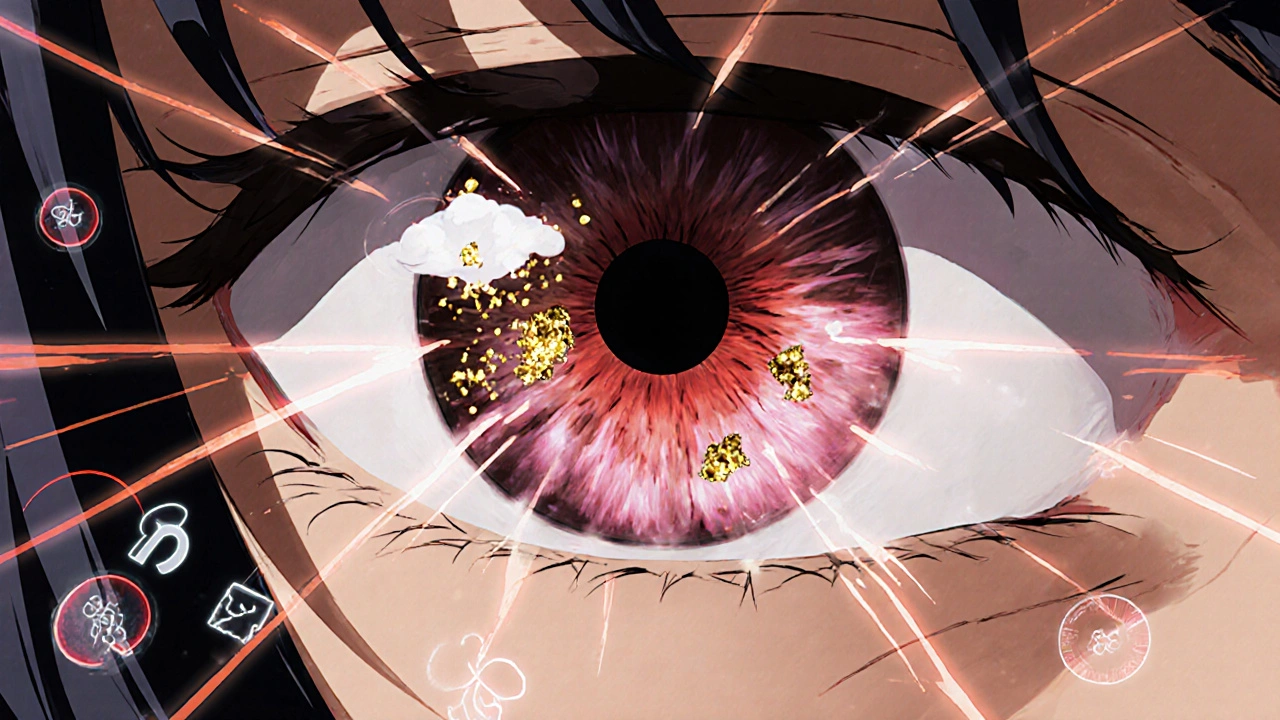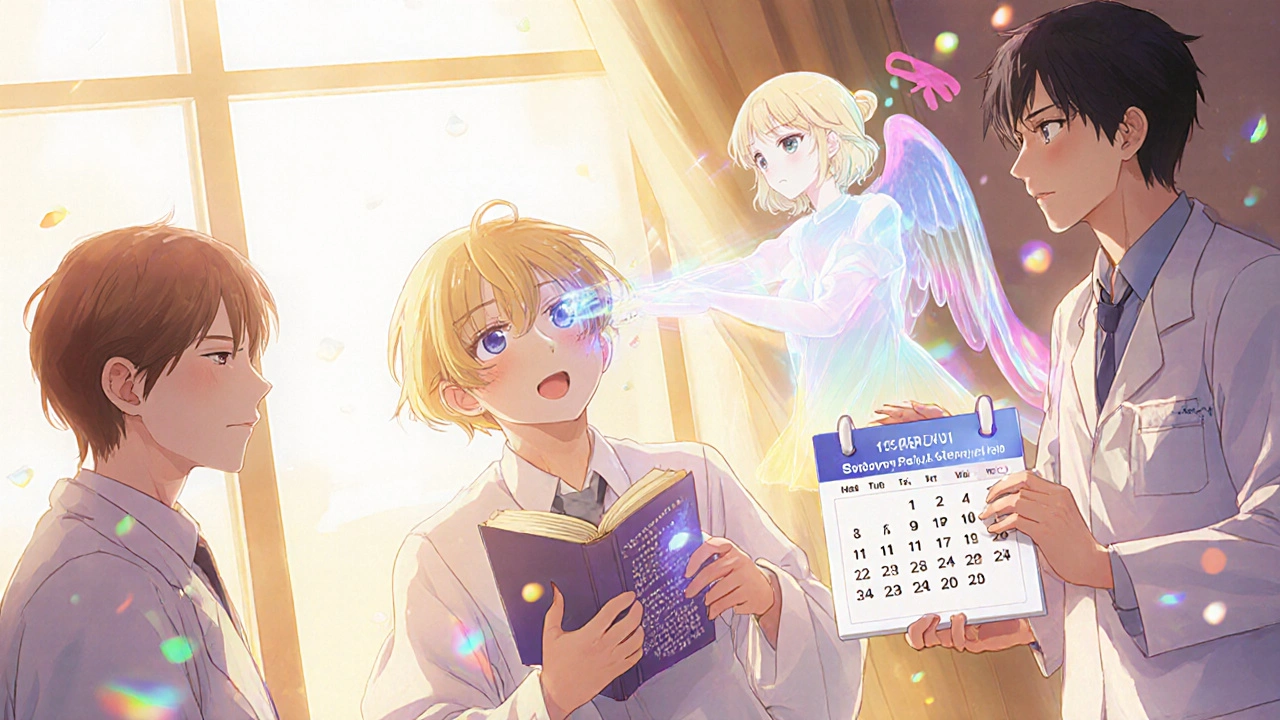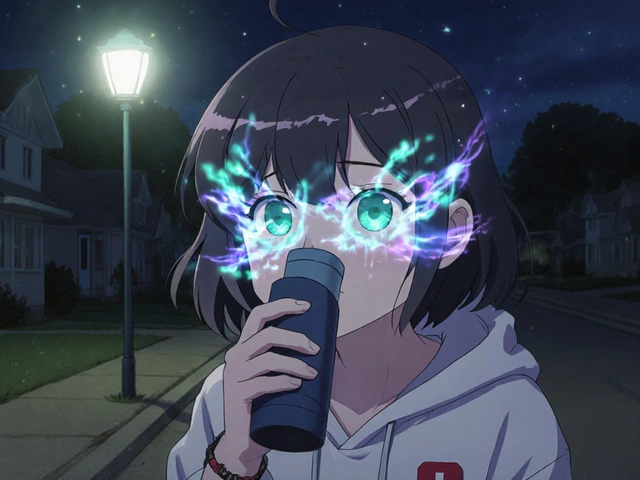Steroid Cataract Risk Calculator
Personal Risk Assessment
Risk Assessment Results
When you’re on long-term steroids - whether for asthma, rheumatoid arthritis, eczema, or an autoimmune condition - your doctor focuses on controlling inflammation. But there’s a hidden risk many patients don’t know about: steroid-induced cataracts. These aren’t the slow, age-related clouding of the lens you hear about in older adults. These develop fast. Sometimes in just a few months. And they can turn everyday tasks like reading, driving at night, or recognizing faces into a struggle.
What Makes Steroid-Induced Cataracts Different?
Not all cataracts are the same. Age-related cataracts usually start as a slow, cloudy haze in the center of the lens. Steroid-induced cataracts? They form at the back of the lens - the posterior subcapsular region. That’s the part of the lens that light passes through first. Even a tiny spot of cloudiness here can scatter light badly, making vision blurry, washed out, or full of halos around lights. This isn’t just a theory. Studies show that over 8% of people on long-term steroid therapy develop this specific type of cataract. And the risk isn’t just from pills. Topical eye drops - the kind prescribed for eye inflammation - carry a 3.2 times higher risk than oral steroids. Inhaled steroids for asthma? Also a known trigger. Even injections or nasal sprays can do it. The timeline is alarming. While age-related cataracts take years to affect vision, steroid-induced ones can show up in as little as 2-4 weeks. By 4 months of continuous use, the risk jumps significantly. And if you’ve had cataract surgery before and have an artificial lens (IOL), you’re even more vulnerable.How Do You Know If You Have One?
The symptoms are clear - and they hit hard:- Blurry vision - reported by 92% of patients
- Colors look faded, like someone turned down the contrast
- Glare or halos around headlights, streetlights, or bright lamps - especially at night
- Double vision in one eye
- Difficulty reading small print or seeing fine details
- Poor night vision - driving becomes risky
- Problems with peripheral vision
Why Do Steroids Cause This?
It’s not just “steroids make your eyes cloudy.” There’s a real biochemical process happening inside the lens. The lens is made of proteins that need to stay perfectly arranged to let light pass cleanly. Steroids interfere with this. Specifically, they bind to lens proteins through a chemical reaction called Schiff base formation, followed by Heyns rearrangement. This creates abnormal protein clumps that scatter light - and these exact clumps are only found in steroid-induced cataracts, not in any other type. On top of that, steroids reduce the eye’s natural antioxidants. Your lens normally fights off damage from free radicals - but steroids weaken that defense. It’s like removing the brakes on a car going downhill. Damage builds up fast. And because the lens has no blood supply, it can’t repair itself. Once the proteins are damaged, they stay damaged.
Who’s at Highest Risk?
It’s not just about how long you’re on steroids - it’s about how much and how you take them.- Dose matters: People taking more than 2,000mg of beclomethasone (a common inhaled steroid) show much higher rates of cataracts.
- Duration matters: Four months of use is a major red flag. Some changes appear in weeks.
- Route matters: Eye drops > inhalers > oral > injections, in terms of relative risk.
- Age matters: Children on long-term steroids are especially vulnerable - ocular hypertension and cataracts are common side effects in this group.
- Existing conditions matter: If you have diabetes or uveitis, your risk doubles.
Can You Reverse It?
The short answer: Not without surgery. Once the lens proteins are clumped and cloudy, no eye drops, supplements, or lifestyle changes can fix it. The only proven treatment is cataract surgery - removing the cloudy lens and replacing it with a clear artificial one (IOL). The good news? Surgery works well. Around 92% of patients report major improvements in vision afterward. Colors become vibrant again. Night driving gets easier. Reading without magnifying glasses becomes possible. But here’s the catch: If you still need steroids after surgery - and many do - your new artificial lens isn’t protected. The same process can happen again. That’s why post-surgery monitoring is critical. Your eye doctor will check for new clouding, pressure changes, or inflammation. Some doctors try to reduce or stop steroids before surgery - but only if the underlying condition allows it. Stopping steroids suddenly can trigger dangerous flare-ups. So this decision must be made with your primary doctor, rheumatologist, or pulmonologist - not just your eye doctor.
How to Protect Your Vision
Prevention isn’t about avoiding steroids if you need them. It’s about managing the risk.- Get baseline eye exams before starting long-term steroid therapy (more than 2 weeks).
- Have checkups every 6 months if you’re on steroids long-term. More often if you’re high-risk.
- Use the lowest effective dose. Never increase your dose without consulting your doctor.
- Ask about delivery method. If you’re on eye drops for inflammation, ask if there’s a lower-risk alternative.
- Report vision changes immediately. Don’t wait for them to get worse.
- Coordinate care. Your eye doctor and your prescribing doctor should talk. Studies show coordinated care reduces vision loss by 37%.
What Happens If You Ignore It?
Left untreated, steroid-induced cataracts don’t just make vision blurry - they can permanently limit your independence. You might stop driving at night. You might stop reading books or using your phone. You might fall more often. You might feel isolated because you can’t see faces clearly. And if you delay surgery too long, your eye pressure can rise, leading to secondary glaucoma - which can cause irreversible nerve damage. The worst part? Many patients only realize the connection between their steroids and vision loss after it’s too late. They blame aging. They blame screen time. They don’t connect the dots - until they’re handed a surgical consent form.Final Thoughts
Steroid-induced cataracts are preventable - but only if you know what to watch for. They’re treatable - but only if you act before they steal your independence. And they’re common - affecting hundreds of thousands of people every year in the U.S. alone. If you’re on steroids - even if you feel fine - talk to your eye doctor. Ask: “Could this be affecting my eyes?” Get a baseline exam. Schedule follow-ups. Don’t assume your vision is just getting worse with age. It might be the medication. Your vision matters. And so does your health. You don’t have to choose between them - but you do need to be informed.Can steroid-induced cataracts go away on their own?
No. Once the lens proteins are damaged and clumped due to steroid exposure, the clouding is permanent. No eye drops, supplements, or lifestyle changes can reverse it. The only effective treatment is surgical removal of the cloudy lens and replacement with an artificial lens.
Are eye drops more dangerous than oral steroids for causing cataracts?
Yes. Topical eye drops carry a 3.2 times higher relative risk of causing posterior subcapsular cataracts compared to oral steroids. This is because the medication is applied directly to the eye, allowing higher concentrations to reach the lens. Even low-dose or short-term use can be enough to trigger changes in susceptible individuals.
How long after starting steroids do cataracts typically appear?
Cataracts can develop as early as 2-4 weeks after starting steroid therapy, though most cases appear within 4-6 months. The risk increases significantly with longer use - especially beyond 4 months. This is much faster than age-related cataracts, which usually take years to become noticeable.
Can I still have cataract surgery if I need to keep taking steroids?
Yes. Many patients continue steroid therapy after surgery. However, ongoing steroid use increases the risk of the new artificial lens becoming cloudy again over time, or developing complications like elevated eye pressure. That’s why regular follow-ups with your eye doctor are essential - even after surgery.
Is there a way to prevent steroid-induced cataracts?
You can’t prevent them entirely if you need steroids, but you can reduce the risk. Use the lowest effective dose for the shortest possible time. Have regular eye exams every 6 months. Avoid unnecessary eye drops. Tell your eye doctor about all steroid use - including inhalers, nasal sprays, and creams. Early detection is the best defense.


Jillian Fisher
October 28, 2025 AT 12:59I never realized how fast these cataracts could develop. I’ve been on inhaled steroids for asthma for over a year and thought my blurry vision was just from staring at screens too much. I’m scheduling an eye exam this week.
Rachel Marco-Havens
October 29, 2025 AT 14:09If you're taking steroids long term and not getting regular eye exams you're basically gambling with your vision. No one's forcing you to take them but if you're too lazy to monitor the side effects don't act surprised when you can't read your phone. It's not rocket science.
Kathryn Conant
October 29, 2025 AT 20:19This is the kind of info that should be screamed from the rooftops. Steroids save lives but they don't come with a warning label loud enough. I’ve seen friends go from reading novels to fumbling with grocery lists in under six months. Don’t wait until you can’t see your own child’s face. Get checked. Now. Your future self will thank you.
j jon
October 30, 2025 AT 18:41My mom had this. She was on prednisone for lupus. Didn’t know until she couldn’t drive at night anymore. Surgery fixed it but she still needs the meds. Now she gets checked every 4 months. Smart move.
Jules Tompkins
October 31, 2025 AT 03:55Imagine looking at the world through a fogged-up bathroom mirror and being told it's just 'aging'. That's what this feels like. I didn't believe it until I saw the halos around my coffee cup lamp. Then I knew. This isn't normal. It's the steroids.
Sabrina Bergas
October 31, 2025 AT 23:47Let’s be real - this whole thing is overblown. The real issue is that doctors push steroids like candy and then act shocked when side effects happen. The lens proteins don’t just ‘clump’ because of some fancy biochemistry - it’s just toxic buildup from systemic drugs. If you’re on them long term you’re already sacrificing your body for convenience. Cataracts are just the first domino.
Melvin Thoede
November 1, 2025 AT 10:03Just had cataract surgery last month and I’m already back on my asthma inhaler. My ophthalmologist said it’s a risk but not a dealbreaker. I’m doing monthly checks and wearing UV-blocking glasses religiously. You can manage this - just don’t ignore it. Vision is too precious.
Suzanne Lucas
November 1, 2025 AT 23:45I cried when I couldn’t read my own birthday card. I thought I was going blind from stress. Turns out it was the nasal spray I’d been using for ‘just a few weeks’ for allergies. Four months later - cataracts. I’m done with steroids. I’d rather sneeze than not see my husband’s face.
Ash Damle
November 2, 2025 AT 00:50Thanks for this. I’ve been on oral steroids for 6 months and thought my dry eyes were the only issue. I’m booking an exam tomorrow. If this helps even one person avoid waiting too long - worth it.